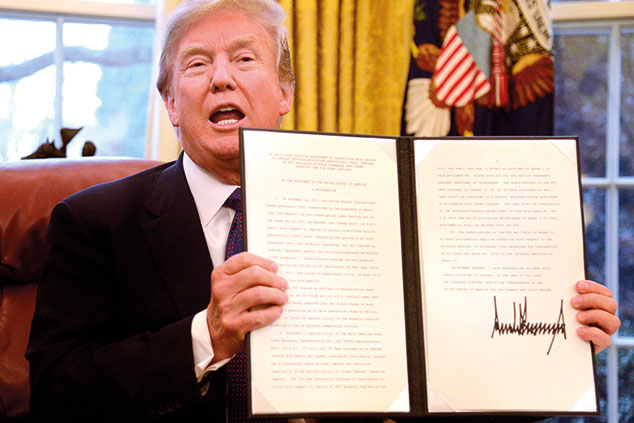
The best investors can say about the first quarter of 2018 is that it’s over, says Vito Racanelli in Barron’s. All major American and world indices slipped between January and March, the first negative quarter since 2015. Investor sentiment has “snapped” along with equities’ winning streak.
In January, stocks appeared set to surge; now, the worry is that the market may have peaked. “After last year’s unnatural calm, we can’t seem to find enough ways
to test our faith in the nine-year bull market,” says Fidelity’s Tom Stevenson in The Daily Telegraph.
We can expect further declines in the short term. As Bloomberg points out, the S&P 500 has just fallen through its 200-day moving average. “Given so much focus has been put on this level, it’s hardly a good sign when it is broken.” Many investment vehicles and automated trading strategies are programmed to sell stocks when certain barriers are hit, rotating into cash or other assets. The 200-day moving average is a popular benchmark of this kind. The so-called “de-risking” process will exacerbate overall selling pressure.
A sea of troubles
The medium-term outlook has deteriorated too. One problem is the technology sector, which has spearheaded the rally. Now that they have incurred political and regulatory scrutiny, the FAANG stocks (Facebook, Apple, Amazon, Netflix, and Alphabet’s Google) have lost altitude, dragging the wider market down with them. But the NYSE FANG + index, which tracks the US and Chinese tech giants, is still in the black for the year. So “if we are really going to reappraise” the FAANG stocks, “there is much further to go”, according to John Authers in the Financial Times.
In the meantime, markets have become rattled by the prospect of a trade war, while the economic data has deteriorated in the past few weeks, suggesting growth may no longer be accelerating. The prospect of interest rates rising faster than anticipated amid a jump in inflation has been another source of anxiety.
Whether we are heading for inflation or a slowdown is not yet clear, but either scenario would constitute an unwelcome departure from the Goldilocks scenario of recent years: growth quick enough to boost profits, but not fast enough to cause concern about overheating and make central banks raise the cost of money.
Take earnings with a pinch of salt
A strong first-quarter US earnings season should foster cheer: the S&P 500 firms increased profits by around 17% year-on-year in the first quarter, the biggest jump since 2011. But much of the surge stems from the corporation-tax cut. Without it, earnings growth would be around 11%, reckons Bloomberg’s Stephen Gandel. And with Wall Street already extremely expensive, there is scant scope for positive earnings news to boost stocks. With headwinds strengthening and tailwinds fading, the market is heading for another difficult quarter.
Europe’s rally has further to go
European stocks have fallen sharply in recent weeks, with the pan-European Stoxx 600 index hitting a one-year low last month. Europe is more exposed to the global economy than the US or Britain, so talk of a trade war has damaged regional equities. But assuming we can avoid one, there should be further gains ahead.
The populist surge in Italy could well spell trouble for the eurozone, but don’t expect anything much to change in the near term. The two main populist parties have toned down their anti-euro rhetoric and the “constitutional obstacles to a Brexit-style referendum… are considerable”, as Adrian Hilton of Columbia Threadneedle Investments told The Times.
Meanwhile, the economic recovery may no longer be accelerating, but growth looks solid. The composite PMI index tracking manufacturing and services has slipped from multi-year highs, but it remains consistent with impressive quarterly growth of 0.5%, notes Capital Economics.
In 2017, GDP growth reached 2.5%, a ten-year high. Along with healthy global growth, this suggests that the earnings recovery should endure. The European Central Bank, unlike its US counterpart, won’t be raising interest rates soon, while relative valuations also favour Europe. Stuart Mitchell of the SW Mitchell Capital European Fund notes that they are more than a third cheaper than US ones.